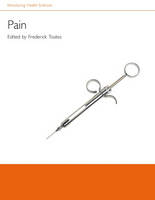
Pain
Oxford University Press (Verlag)
978-0-19-923736-4 (ISBN)
- Titel ist leider vergriffen;
keine Neuauflage - Artikel merken
Pain is a paradoxical phenomenon - aiding human survival by warning us to retreat from damaging stimuli and rest while injuries heal, and yet causing immense human suffering when it becomes intractable. This is one of many puzzling features of pain examined in this book. What common properties are shared by pains triggered by noxious stimuli such as cuts and those triggered by social rejection, or empathy with the pain of another? How can a placebo, an inert substance which someone believes is an analgesic, reduce the pain of a migraine or a sprained ankle? The central argument of Pain is that only an integrated understanding of biology and psychology can explain the roots of pain in the nervous system and the relationship with mental events in modifying the experience of pain. Interactive animations on the accompanying DVD illustrate how tissue damage initiates signals in the nervous system, which the brain perceives as pain at the site of the injury. Videotaped interviews with people suffering from chronic pain and with health professionals working in pain clinics illuminate the underlying theories of pain and its treatment in the context of personal accounts.
A discussion of the 'gate theory' of pain provides a scientific rationale for the efficacy of placebos and cognitive therapies in treating the pain of a physical stimulus. This leads to an explanation for the exacerbation of pain when people make catastrophic interpretations of their situation and its alleviation by techniques such as visualisation. The book concludes with an explanation of the 'placebo effect' and a discussion of different methods of treating pain, including surgical and chemical interventions and psychological techniques, illustrated by videos and animations on the DVD. The Online Resource Centre features: For lecturers who are registered adopters of the book: - Figures from the book in electronic format, available to download For students: Access to ROUTES, a searchable internet database of online resources compiled by academic staff and subject-specialist librarians.
Frederick Toates is Professor of Biological Psychology at the Open University, having previously held teaching positions at both the University of Odense, Denmark, and the University of Central Lancashire. In addition to publishing widely in peer-reviewed journals, Fred has contributed materials to several Open University course texts. He is also author of the textbook Biological Psychology (Pearson Education).
1. Pain: a global health problem ; 1.1 A sensory and emotional experience ; 1.2 A psychobiological approach to pain ; 1.3 Measuring pain ; 2. Describing and classifying pain ; 2.1 The time factor ; 2.2 The range of uses of the term 'pain' ; 2.3 A fundamental distinction ; 3. How to explain pain: The basic principles ; 3.1 Pain, evolution and the human zoo ; 3.2 The nature of pain ; 3.3 Interacting factors underlying pain ; 3.4 The link between stimuli and pain ; 3.5 Sociocultural, religious and gender factors ; 3.6 The role of the brain ; 3.7 The study of mind and consciousness ; 4. How the body works ; 4.1 Body systems ; 4.2 Cells ; 4.3 Homeostasis ; 4.4 The endocrine system ; 5. The nervous system ; 5.1 Nerves, neurons and axons ; 5.2 Types of neuron ; 5.3 The role of neurons ; 5.4 How neurons perform their role? ; 5.5 Synapses ; 5.6 Some details of the brain ; 5.7 The somatic and autonomic nervous systems ; 6. A focus on pain and the nervous system ; 6.1 The periphery ; 6.2 The spinal cord ; 6.3 The brain ; 6.4 Anomalies of pain ; 6.5 Relating nociceptive pain to psychogenic pain ; 7. Treating pain ; 7.1 Chemical interventions ; 7.2 Transcutaneous electrical nerve stimulation ; 7.3 Surgical intervention ; 7.4 Psychological intervention ; 8. Placebo effects ; 8.1 Explaining the placebo effect ; 8.2 The psychobiology of the placebo effect ; 8.3 Implications of the placebo effect ; 9. Final word ; 9.1 A challenging puzzle ; 9.2 Revelance of the meaning of 'psychological' and 'psychogenic' ; 9.3 Practical implications
| Erscheint lt. Verlag | 13.9.2007 |
|---|---|
| Zusatzinfo | 60 full colour illustrations |
| Verlagsort | Oxford |
| Sprache | englisch |
| Themenwelt | Medizin / Pharmazie ► Medizinische Fachgebiete ► Schmerztherapie |
| Medizin / Pharmazie ► Pflege | |
| Studium ► Querschnittsbereiche ► Epidemiologie / Med. Biometrie | |
| Studium ► Querschnittsbereiche ► Prävention / Gesundheitsförderung | |
| ISBN-10 | 0-19-923736-0 / 0199237360 |
| ISBN-13 | 978-0-19-923736-4 / 9780199237364 |
| Zustand | Neuware |
| Informationen gemäß Produktsicherheitsverordnung (GPSR) | |
| Haben Sie eine Frage zum Produkt? |
aus dem Bereich


